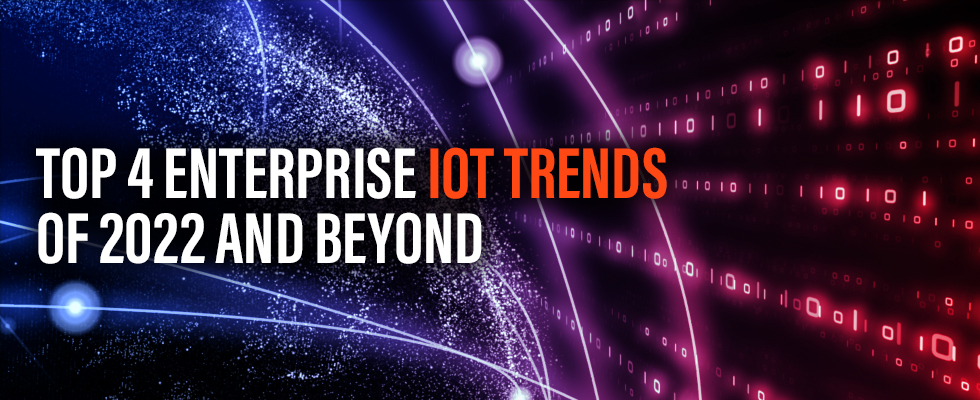While the Internet of Things (IoT) has been a mainstream concept for more than a decade, we’re finally entering the age where widespread adoption amongst enterprises is occurring.
In fact, one report found that the industrial IoT market grew 22.4 percent last year, increasing to $157.9 billion. And this trend is not expected to subside anytime soon, with the IoT market expected to eclipse $1.3 trillion by 2032.
This growth is due to the fact that industrial IoT investments can have a profound impact on enterprise operations. Not only can IoT devices increase staff productivity through automation, they can also help ensure efficient operations, reduce costs, and unlock additional business opportunities (e.g., via analytics, artificial intelligence, and smart technology).
With all this in mind, let’s take a look at four of the more prevalent IoT trends that are transforming the way enterprises do business.
Table Of Contents
Industrial IoT Trend #1. 5G
Making the most out of IoT infrastructure starts with lightning-fast connectivity. This is precisely why more and more enterprises are investing in 5G networks or partnering with providers that can support real-time decisioning — and actual real-time decisioning, too, at sub-10 millisecond speeds.
With 5G networks powering IoT devices, organizations benefit from high bandwidth, near-zero latency, and robust quality of service. This enables them to unlock a number of new use cases and revenue streams.
Also, 5G makes it significantly cheaper to move and reconfigure machinery. And with its ultra-wideband connectivity (above 6GHz), 5G provides this advantage without compromising on latency or speed.
Industrial IoT Trend #2. Security
While IoT devices can deliver a ton of benefits to enterprises, they’re not without their risks. Chief among them? Increased security concerns. In fact, one recent report from Kaspersky revealed that there were 1.5 billion attacks against IoT devices in the first six months of 2021 alone.
A full 83% of medical imaging devices use unsupported operating systems, and due to discontinued support for Windows 7, 56% more devices are now more vulnerable to cyberattacks and malware than they were in 2018.
As more and more endpoints go online, organizations have an increasing number of devices to manage — and bad actors have an increasing number of areas to attack. As a result, IoT devices face a number of security issues, including data breaches; malware, ransomware, and distributed denial of service (DDoS) attacks; and outdated software.
The takeaway? Enterprises that invest in IoT solutions need to understand these security risks and proactively protect against them. Commoditizing IoT devices and moving the computation out of these devices and into an integration layer can prevent direct network access and allow an intermediary layer to incorporate both data context and security checks.
Industrial IoT Trend #3. Edge computing
Edge computing, enterprise IoT, and 5G are three peas in a pod. Since speed is the name of the game, more and more organizations are moving workloads to the edge to accelerate data analytics and decisioning and increase business productivity.
Rather than transmitting data to central data centers, edge computing enables processing to occur closest to the edge devices instead, speeding up decisioning by reducing latency while providing valuable context for intelligent decision-making.
At the same time, edge endpoints will still be connected to central and cloud data centers via 5G networks, which helps enterprises with things like alerting and other notifications, along with sending aggregated and raw data in the background for further analytics that incorporates machine learning.
Industrial IoT Trend #4. Industry 4.0
At a high level, a mature enterprise IoT market promises to transform the way many organizations do business. For example, many manufacturing companies are automating their warehouses as much as possible to speed up workflows and free employees to focus on other pressing matters. Additionally, enterprises across all industries are turning to wearable and telemetry devices for a number of use cases, including digital twins,training, and safety management.
What’s more, organizations are using IoT tools to keep tabs on machine performance and maintain equipment. To illustrate, rather than sending a technician around to make sure everything is running smoothly, organizations can receive automatic notifications from IoT sensors when things aren’t working correctly or using machine learning inferencing when things are about to stop working correctly.
As IoT continues to evolve, organizations will be able to make use of more and more 5G applications and use cases. Over time, this will help them build more efficient businesses.
Industrial IoT Trends of 2022: Final Thoughts
In many ways, the enterprise IoT era has finally arrived. But as 5G networks and edge computing investments proliferate, we will begin to see what the true promise of enterprise IoT looks like.
With businesses becoming more efficient, employees reclaiming time thanks to automation, and 5G applications becoming the norm, there’s no shortage of things to be excited about in this space.


